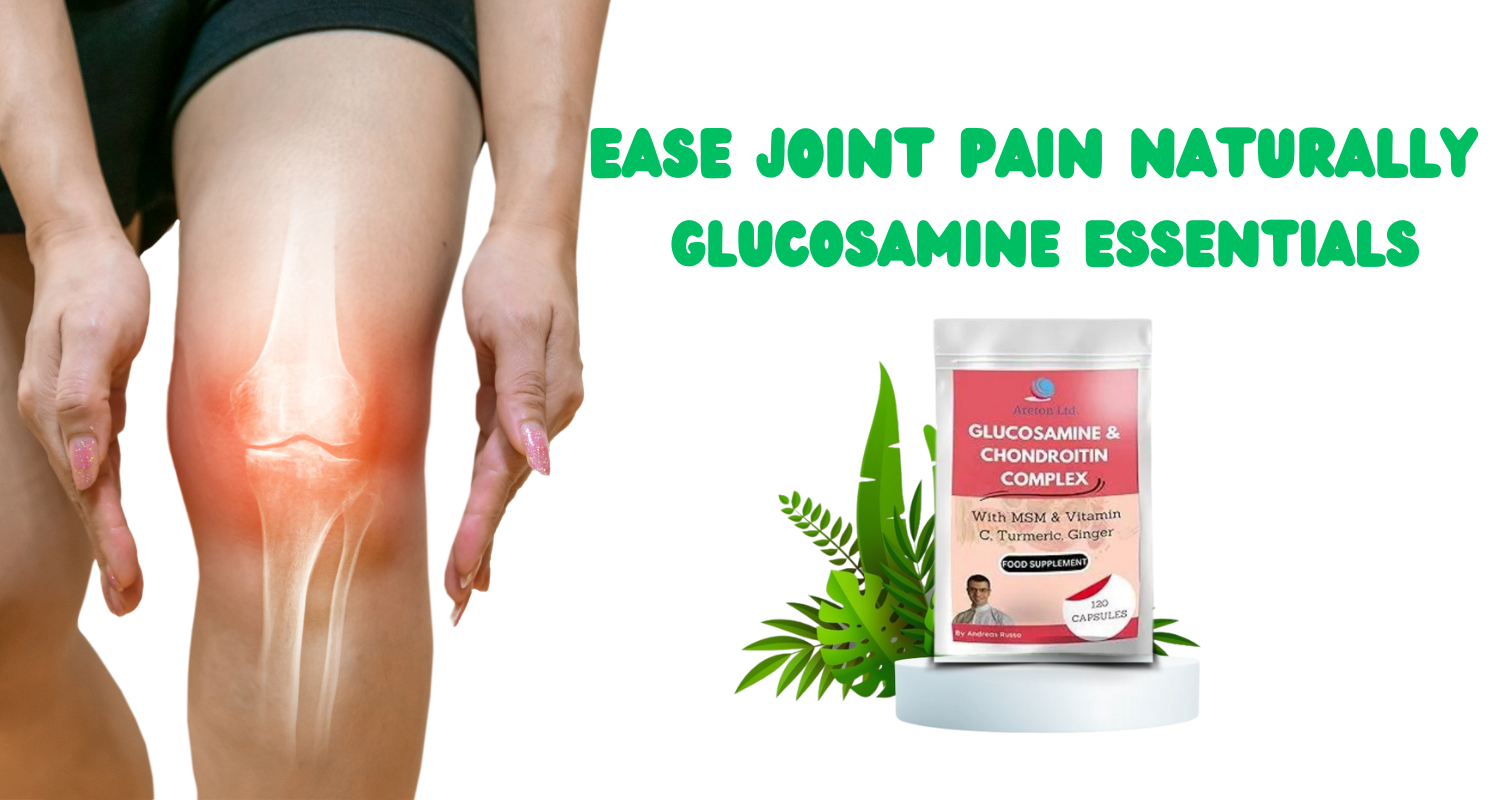Stay Active: Glucosamine Trio for Joints
Joint pain is extremely common and affects people of all ages. It can range from mild discomfort to debilitating pain that impacts mobility and quality of life. There are many potential causes of joint pain including osteoarthritis, rheumatoid arthritis, injuries, overuse, and aging. While there are prescription medications that can help manage joint pain, many people seek out natural alternatives due to concerns over side effects.
One popular natural supplement for joint health is glucosamine. Glucosamine is a compound that occurs naturally in the body and is a building block for cartilage, tendons, ligaments and synovial fluid. It plays an important role in cushioning the joints and allowing them to move smoothly. Glucosamine supplements have gained popularity as a way to promote joint mobility and reduce pain related to osteoarthritis. Research has shown that glucosamine can help rebuild cartilage, improve joint lubrication, decrease inflammation and potentially slow the progression of osteoarthritis.
This article will provide an in-depth look at how glucosamine works, the different forms and dosages, its benefits for joint health, safety considerations, and tips for choosing a quality glucosamine supplement. The goal is to provide the essential information needed to determine if glucosamine is right for easing joint discomfort and improving mobility.
What is Glucosamine?
Glucosamine is a natural compound found in healthy cartilage and connective tissues. It is made from chains of sugars and proteins, and helps provide structure and elasticity to tissues like cartilage, tendons, ligaments, and synovial fluid.
In the body, glucosamine is synthesized from glucose and the amino acid glutamine. It helps stimulate the production of glycosaminoglycans and proteoglycans – compounds found in cartilage that help cushion joints.
Glucosamine can be obtained through food sources like shellfish or produced through fermentation processes. The two most common forms of glucosamine supplements are:
Glucosamine hydrochloride – the hydrochloride salt form, usually made from chitin in shellfish.
Glucosamine sulfate – the sulfate salt form, often derived from shells of shrimp, lobster or crab.
Glucosamine production involves the hydrolysis of chitin from crustacean shells to release N-acetylglucosamine. This compound is then further processed to create glucosamine supplements.
As a nutritional supplement, glucosamine provides building blocks for cartilage production and repair. It helps stimulate cartilage cells called chondrocytes to synthesize new cartilage components. This can help support joint health and mobility.
How Glucosamine Eases Joint Pain
Glucosamine is thought to work by stimulating the production of cartilage components like collagen and proteoglycans. It may also help inhibit enzymes that break down cartilage.
Specifically, glucosamine sulfate seems to:
Reduce inflammation that can lead to joint cartilage breakdown. Research shows it lowers levels of compounds involved in inflammation, like interleukin-1.
Prevent the activation of inflammatory enzymes called matrix metalloproteinases, which normally break down cartilage.
Potentially help build and repair cartilage by providing building blocks like sulfur and proteins. Glucosamine sulfate provides the raw materials for making glycosaminoglycans found in cartilage.
Stimulate production of synovial fluid, which lubricates joints and contains compounds that nourish cartilage.
So in summary, glucosamine eases joint pain by reducing cartilage breakdown through anti-inflammatory effects and stimulating cartilage repair by supplying it with essential nutrients. It helps restore cartilage and fluid to cushion joints.
Types of Glucosamine
There are several forms of glucosamine used in supplements:
Glucosamine sulfate
Glucosamine sulfate is one of the most common and studied forms of glucosamine. It consists of glucosamine bound to a sulfur molecule. Some research suggests glucosamine sulfate may be more effective at reducing pain and inflammation compared to other forms.
Glucosamine hydrochloride
Glucosamine hydrochloride is another common form found in supplements. It consists of glucosamine bound to a hydrochloride (HCl) group. There’s some debate whether glucosamine hydrochloride is as effective as glucosamine sulfate. However, glucosamine hydrochloride may be beneficial for people who are sensitive to sulfur.
N-acetyl glucosamine
N-acetyl glucosamine is a form of glucosamine combined with an acetyl group. Some research indicates it may have anti-inflammatory effects and support gut health. However, there’s less evidence on the benefits of N-acetyl glucosamine for joint pain compared to other forms.
The different forms provide varying amounts of elemental glucosamine. Glucosamine sulfate is generally considered the most clinically effective form for osteoarthritis and joint pain relief. However, individuals may respond differently to each type.

Recommended Glucosamine Dosage
The typical recommended dosage for glucosamine supplements is 500-1500 mg per day. Most studies showing benefits use dosages in this range.
For osteoarthritis, the most common dosage is 500 mg three times per day, or 1500 mg total daily. Some experts recommend starting with a lower dose around 500 mg once or twice daily and increasing if needed.
Lower dosages around 500 mg once daily may be suitable for general joint health and prevention. Those with more severe joint pain can consider higher doses up to 2000 mg per day by taking 500 mg doses 4 times daily.
It’s best to take glucosamine in divided doses throughout the day for maximum absorption and effect. Most supplements come in 500 mg or 750 mg capsules.
Some glucosamine supplements combine glucosamine sulfate with chondroitin and/or MSM for additional joint benefits. In these combination products, the glucosamine dosage may be lower since you’re getting multiple ingredients.
Follow dosage recommendations on the specific supplement label. Work with your healthcare provider to determine the optimal glucosamine dosage for your individual needs.
Benefits of Glucosamine
Glucosamine has been shown to provide several key benefits for joint health and mobility:
Relieve Osteoarthritis
Multiple studies have found that taking glucosamine supplements can significantly reduce osteoarthritis pain and improve joint function. Osteoarthritis causes cartilage between joints to break down, leading to pain, inflammation, and stiffness. Glucosamine may help rebuild cartilage and slow the progression of osteoarthritis. In one study, people with moderate to severe knee osteoarthritis taking glucosamine sulfate saw reduced pain and improved mobility after 6 weeks.
Reduce Joint Pain
Glucosamine can help relieve joint pain from various causes. It appears to have an anti-inflammatory effect that can decrease swelling, tenderness, and discomfort in joints. In a 3-year study, people with chronic knee pain taking glucosamine hydrochloride experienced less joint pain and improved function. The pain-relieving benefits were seen in as little as 2 weeks.
Improve Mobility
By lubricating joints, stimulating cartilage repair, and reducing inflammation, glucosamine can enhance mobility and flexibility. Clinical studies show people taking glucosamine have greater range of motion and find it easier to walk, climb stairs, and perform daily activities requiring joint movement. The improvements in mobility can be especially helpful for seniors and those with arthritis.
Glucosamine Safety and Side Effects
Glucosamine supplements are generally considered safe when taken as directed. The majority of users do not experience any side effects. However, some people may develop mild side effects like:
- Nausea
- Heartburn
- Diarrhea
- Constipation
- Headache
- Fatigue
- Skin reactions
These side effects are usually temporary and resolve within a few days after stopping the supplement. The most common side effect reported is mild digestive upset like nausea, heartburn or diarrhea. This can be avoided by taking glucosamine with food.
There are very few drug interactions with glucosamine. However, glucosamine may interact with diabetes medications, blood thinners, diuretics or NSAIDs. Those on prescription medications should consult a doctor before starting glucosamine.
Rarely, some people may be allergic to shellfish and should avoid glucosamine derived from shellfish exoskeletons. Vegetarian options made from fungal sources are available.
At recommended doses, glucosamine is considered safe for most people. Those with pre-existing health conditions should be cautious and consult a doctor first. Start with a low dose and monitor for any side effects. Discontinue use if any worrisome reactions occur.
Glucosamine Interactions
Glucosamine supplements may interact with certain medications. Here are some key interactions to be aware of:
Diabetes Medications – Glucosamine may increase insulin resistance and blood sugar levels. If you take diabetes medications, monitor your blood sugar closely when starting glucosamine. Your doctor may need to adjust medication dosage.
Warfarin – Glucosamine may increase bleeding risk when combined with the blood thinner warfarin. Those on warfarin should have INR monitored and warfarin dosage adjusted accordingly if taking glucosamine.
Chemotherapy – There is some evidence that glucosamine may reduce effectiveness of certain chemotherapy drugs. It’s best to avoid taking glucosamine if you are undergoing chemotherapy until more research is available.
Always consult your doctor before taking glucosamine, especially if you take any medications regularly. They can review potential interactions and help determine if glucosamine is appropriate for your individual health situation. Being aware of interactions allows you to use glucosamine safely and effectively.
Choosing a Glucosamine Supplement
When selecting a glucosamine supplement, there are several key factors to consider:
Purity
Look for products that contain glucosamine sulfate or glucosamine hydrochloride as the main active ingredient. Avoid products with unnecessary fillers, additives, and artificial ingredients. The purer the supplement, the more effective it will likely be.
Potency
Glucosamine is typically dosed at 1500mg per day for joint health. Choose a supplement that provides an adequate daily dosage, often requiring 2-3 capsules. Make sure the product lists the amount of glucosamine per serving on the label.
Formulation
Glucosamine sulfate is thought to be more effective than glucosamine hydrochloride. Opt for the sulfate form if possible. Capsules are preferred over tablets for better absorption.
Quality Standards
Select products made by reputable manufacturers following good manufacturing practices (GMP). Look for seals of approval from organizations like NSF International or USP that certify purity and potency standards.
Value
Compare products to find a high-quality glucosamine supplement that provides good value. Calculate the cost per dose to determine which offers an affordable price point.
Money-Back Guarantee
Choose supplements that come with a customer satisfaction guarantee in case the product does not work for you. This ensures you can get your money back if dissatisfied.
Conclusion
Glucosamine supplements can provide an effective and natural way to manage joint pain and support cartilage health. When taken correctly and consistently, glucosamine has been shown to significantly reduce inflammation, improve joint mobility, slow cartilage breakdown, and even help rebuild cartilage.
The benefits of glucosamine stem from its ability to boost the production of glycosaminoglycans, proteoglycans, and hyaluronic acid which make up cartilage and joint fluid. By supporting healthy cartilage, glucosamine may prevent and treat osteoarthritis. It can ease joint pain and stiffness without the side effects of NSAIDs or other medications.
When choosing a glucosamine supplement, opt for a reputable brand providing glucosamine sulfate or hydrochloride. Follow the dosage recommendations to get the desired anti-inflammatory and cartilage-building effects. Give glucosamine at least 4-8 weeks for maximum results. Combining it with chondroitin provides additional joint benefits.
Overall, glucosamine is a safe, natural supplement that can significantly improve joint health and mobility. It offers a way to manage arthritis, sports injuries, and joint pain without drugs. Adding glucosamine to your daily routine can support healthy, flexible joints for years to come.


